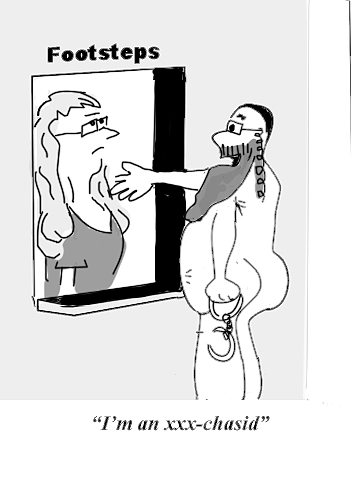On Arranged Marriage
It’s wonderful that the young Hasidic boy or girl is asked “do you like him/her” of the future spouse before an engagement is finalized. The couple spends on average half an hour together on their one and only date, mumbling about absolutely nothing important while the parents hover anxiously outside the door. Usually, the couple would not even be interacting with first person pronouns out of respect for the stranger; they would be punctuating the formal Q&A with painfully awkward silences while unable to will their virgin eyes to make eye-contact. And then they are to announce a liking for that to-be fiancé’!
I spent more time deliberating if I like the pet frog we adopted than I did deliberating if I like the husband I started a Hasidic family with.
It’s a sly trap they got because it’s hard not to like someone you only shared a table with for half an hour, at age eighteen, fresh off the gender separated boat. Girls are promised balloons and flowers and a fancy white gown and boys get to throw around pens and cigarettes and get released from yeshiva. So there’s some nebech sitting across the date table clacking teeth like a nervous wreck. What’s not to like in a poor person like that?
So you like him or her. Just like on Facebook. One little “like” you give. That’s it. And boom, married.
There, mazel tov, mazel tov. Or as my pet frog says it best: ribbit ribbit.
On the X-Hasid
The ex-chasid has become a very popular phenomenon. Ex-chasidim comprise those men or women who somehow disenfranchised themselves from chasidism and — complete with language barrier and culture shock — set out to make a new life for themselves. People who did the same some twenty years ago tell me of the loneliest journey, in which they alone set out to disentangle themselves from their extreme past and make a life in the overwhelming Americhka, without another Yiddish soul to understand them. But things are very different today. Ex-chasidim are to be had a dime a dozen of every stripe and personality. There are formal and informal groups of social support, there are online forums and there’s Footsteps, an organization specifically founded with the goal to aid those who leave the Chasidic community.
But of course, cha! What kind of weasely chasid doesn’t know how to take it up two notches and become an xxx-chasid?
Rumor has it that indeed, the provocative xxx-chasid who despite his full pious garb behaves sexually suggestive exists a dime a dozen too. Perhaps. Or perhaps it’s one of those skewed incidents that exist less frequently but have nonetheless become a common stereotype to most outsiders.
On Chasidic Women
Recently, Chasidic women became the subject of much heated debate after a fluffy little article by a Chabad woman named Chaya sparked inter-web-wide conversations. Let me precede by saying that I am absolutely qualified to add to the conversation since I am NOT a chabad woman and NOT a baales tshuva (yet) and NOT even Satmar (anymore). And because I have many siblings and friends who are true, authentic, Satmar Chasidic women.
What troubled me about these recent conversations was the absence of a single Satmar woman’s voice. We heard Deborah Feldman, who was Satmar in one of her pre-celebrity incarnations, and I am writing, having been Satmar without any celebrity incarnations, but Satmar women themselves said nothing. Can a Chaya from Satmar speak up? I assume the task of trying to explain what drives a Satmar woman feels impossible to any one of them. And Satmar women too seem to have resigned to the reality that the outside world just doesn’t get them.
It is indeed true that Satmar women shave their heads. Yes, indeed they are taught not to use birth control. Yes, they are relegated to the women’s section and unwelcome at male events. They are required to dress to the inch of the law of the town, and they do not choose their husbands. They send their underwear to the rabbi. They are not allowed to drive.
It is a life of law and limits for a Satmar woman.
But what do Satmar women say about these rituals? How do Chasidic women keep sending off underwear while they wait for the secular media to swoop in and liberate them? Can we try to understand what compels a Chasidic woman to adhere to these rituals and pass it on to her children?
Chasidic women live in a radically different culture than the secular American culture, and their world is more complicated and nuanced than the mere sum of these rituals. Things that seem strange and unjust to outsiders are natural and non-issues to Satmar women. A combination of indoctrination and very little exposure to different ideas makes for a community of women who themselves know only a world of motherhood and piety. They invest themselves in the home and find power and passion within the framework of their available religious outlets.
As a woman’s history student myself (yes, baby!), I often, in my studies, come across scenarios of women who voluntarily took upon themselves the most extreme stringency of religion. Nuns who fasted for days or Indian widows who jumped into the fire; these are extreme examples of women who embraced their religious, patriarchal setting and found passion and power within it. They did not want to be liberated.
In Chasidic culture, most women embrace their lifestyle and expand on the rules and regulations. Many women WANT to have many babies even while rabbis increasingly dispense birth control. These women direct their energy towards their children because it’s a community that invests itself towards its future generations, and because women find motherhood to be their only venue to express their passion and interest. And many find joy in these things. A woman without a baby will sit among her friends conspicuously childless, feeling as empty and misplaced as a secular woman without a career. A good friend of mine recently visited a rabbi for a blessing of a child, after five children and three years without another pregnancy.
When I was Chasidic, the women were the ones who were often the imposers of the law: the Chasidic women washed my back in the mikvah and commented on the length of my shaven hair; the women criticized my open neckline or sent me letters in the mail about my deviances; the women encouraged new rules to enhance community purity and stringencies.
Of course, as I became disenchanted and increasingly frustrated with the Chasidic lifestyle, I no longer understood the passion or conviction Chasidic women find in their lifestyle. I was no longer able to shave my head or send my underwear in the most nonchalant way. I began to experience everything that was previously sacred and natural as oppressive and strange.
Chasidic women may be content to spend their day washing dirty faces, rocking the baby carriage, preparing flowers for the holiday, washing the floors until the apartment smells of Mr. Clean and Challah and dressing the family in their holiday best. Perhaps in the midst of all this they also check their vagina for blood. It’s five seconds of their day and it’s hardly what they think about when they go to sleep at night.
The same experiences can feel suffocating and outrageous to Deborah Feldman and others like her who are on the fringe or who already left. Because once someone does not want to belong to the community, once someone chooses another lifestyle, there is hardly a way out. With a cloistered community that believes in the ultimate law, the community rears its ugly head at those that test its limits. That’s an ugly side many content Satmar women who toe the line never know, and I didn’t know until I began to ask for more myself.
We can decry Satmar women’s oppression and demand their liberation. But we’ll be missing the point. Satmar women don’t want to be saved. But problems exist in the community that need to be addressed. Increasing awareness and resources for Chasidic victims of domestic violence or women (and men!) who want to leave are some of the ways we can have a conversation about the problems in the Chasidic community without narrowly judging a people from the prism of our own culture.
On Cheese-and-Dairy parties
Who could turn down cheese yodels and milk-chocolate balls and cheesecake and really warm and sweet kreplech with buttery crumbs on top? That’s what we get for accepting the Torah. They bribed us. And with flowers too. What a romantic divine, courting us and wooing us in. To that I say “I’ll do and I’ll hear and I’ll eat too”. Bring it on.
Happy Cheesecake Time!
On Banning the Internet
The rally at Citifield was historic. I was outside and the crowds there were unbelievable. But then again, the crowds online on Facebook and on discussion groups are even better! And that’s what’s really historic. We shall all see if the crowds online will disperse after the Rabbis said that internet should only be used at home.





